Wednesday, August 31, 2022
Before Death By Suicide, Man Texted Colleagues He Was Upset With: Cops
Webinar: Paid and organic search harmony can skyrocket your results

We hear a lot of talk about SEO and Paid Search living together in perfect harmony, side by side on your search engine results page, but how do we?
The cost of unnecessary paid brand clicks quickly adds up. Especially if you’re already dominating your SERP (search engine results page). This can feel like an uphill battle for you and the team as economic sentiment continues in uncertainty and spend efficiency is still top of mind.
Join Gary Galloway, Senior Director of Product Marketing at Adthena, as he covers how you can support growth strategies and help your brand achieve SERP while also decreasing costs
Register today for “Skyrocket your results with organic and paid search harmony,” presented by Adthena.
The post Webinar: Paid and organic search harmony can skyrocket your results appeared first on Search Engine Land.
from Search Engine Land https://ift.tt/gvbo1f8
via https://ift.tt/MmdUuN2 https://ift.tt/gvbo1f8
AAP MLAs Protest Outside CBI office, Demand Probe Into "Operation Lotus"
Tuesday, August 30, 2022
Mumbai's Lalbaugcha Raja Offers Online Prasad Service On Ganesh Chaturthi
Delhi Man Murdered Over Rs 100 To Buy Ganja; Cops On 2-Hour Foot Chase
Man Rapes Tribal Girl, 15, Inside Her House In Jharkhand, Arrested: Cops
Man, 25, Sentenced To 20 Years In Jail For Raping Minor In UP: Report
Webinar: Harness first-party data for conversion

In order to retain and grow existing customer relationships, leading organizations are betting on first-party data solutions that can drive impact for both acquisition and retention initiatives.
Join ActionIQ and Hearst’s VP of acquisition and conversion as they discuss how Hearst is unlocking value by leveraging its first-party data to drive conversion across both subscriber and e-commerce products.
Register today for “Harness Your First-Party Data For Customer Acquisition & Conversion,” presented by ActionIQ.
The post Webinar: Harness first-party data for conversion appeared first on Search Engine Land.
from Search Engine Land https://ift.tt/wKeS5pX
via https://ift.tt/7LVvAw9 https://ift.tt/wKeS5pX
Google Business Profile guidelines updated to include products
Retail businesses can now add in-store products to their Google Business Profile listings.
How it works. When customers search for a Business Profile they can find a products carousel (on the Maps mobile app), or a carousel and “Products” tab if they’re using Google Search.
With the “Products” tab, customers can:
- Click a featured product card to view the product details.
- Click a product category to view an overview.
- Click a product within a product category to view the product details.
- Chat or call you to find out more, or click on the button leading to your website to order online.
- Provide feedback in case there are copyright or legal issues.
How to add products. There are two ways to add products to your Business Profile.
- Manually with the Product Editor
- Use Pointy app with your Point of Sale (POS) system
To preview how products will appear to customers on Google Search, managers can click See it on Google about a minute or two after uploading.
Required guidelines. retailers and advertisers who want to add products to their Business Profiles must follow Shopping Ads policies.
Additionally, Google does not allow regulated products such as:
- Alcohol
- Tobacco
- Gambling
- Financial services
- Pharmaceuticals
- Unapproved supplements
- Health & medical devices
Read more. The new Products section was spotted on Twitter by Stefan Somborac. You can learn more about setting up products on your Google Business Profile here.
Google updated the Guidelines for Business Profiles with a new section: Products.
— Stefan Somborac (@StefanSomborac) August 30, 2022
Google wants you to add product information to your Business Profiles!
Either:
1.) Manually add products with Product Editor (in your Business Profile)
– OR –
2.) Add products using Pointy
1/3
Why we care. Allowing shoppers to browse items and prices before walking into a store can help increase visits and sales from both new and returning customers. With the holiday shopping season fast approaching, retailers and advertisers who can add products to their Google Business Profiles, and want increased visibility, should do so as soon as possible.
The post Google Business Profile guidelines updated to include products appeared first on Search Engine Land.
from Search Engine Land https://ift.tt/GpFjESx
via https://ift.tt/7LVvAw9 https://ift.tt/GpFjESx
When Noida Twin Towers Were Demolished, Air Pollution Spiked This Much
Monday, August 29, 2022
Manish Sisodia At Bank, CBI To Check Locker In Alleged Corruption Case
Probe Against UP Official For Not Recognising Smriti Irani Over Phone
YouTube is testing a new “Promotions” Tab
YouTube has added a Promotions Tab to let creators promote their channels and videos without needing to go through the Google Ads Manager.
The new Promotions Tab is within YouTube Studio and is a way to make buying ads easier, versus going through the traditional Google Ads Manager route. If creators have access to the new tool, they’ll find the tab within the Promotions section on the Content Page of Studio.
What YouTube says. YouTube thinks the new Promotions Tab will get a lot more channel managers running quick promotions for their content.
“We’ve heard that creators want more tools to help grow their channel and reach a wider audience, so we are testing a simpler end-to-end workflow in Studio instead of through Google Ads. If you’re in this experiment, you’ll see a new “Promotions” tab in the Content page of Studio.”
Read the announcement. You can read the announcement from YouTube here.
Why we care. The new feature allows channel creators and advertisers to grow their channels without having to deal with Google Ads. However, it’s also a way for YouTube to bring in more ad revenue. Channel creators who didn’t have the knowledge to run channel or video promotions through a complicated platform such as Google Ads can now do so more easily. But creators who are new to the platform should exercise caution, learn Google Ads best practices, and test their Promotions with a small budget before scaling.
Experienced advertisers can also use the Promotions Tab. Though most would likely opt out and stick to the traditional Google Ads method.
The post YouTube is testing a new “Promotions” Tab appeared first on Search Engine Land.
from Search Engine Land https://ift.tt/TqaE49X
via https://ift.tt/GIxKaBd https://ift.tt/TqaE49X
Google tests Quick Read, 5 Min. Read labels in search results
Google is testing two new labels in search results:
- Quick Read
- 5 Min. Read.
What it looks like. The labels were shared on Twitter. Here are screenshot of both types, via @Ozaemotion and @lilyraynyc:


Short content can be helpful content. For nearly a decade, skyscraper content and 10x content have been popular concepts. In short, the idea behind both was that “length is strength.”
Some SEO correlation studies appeared to back up the idea because Page 1 of Google is full of articles at 1,000+ words.
However, word count is not a ranking signal. And searchers have been growing tired of clicking on articles that discuss the entire history of a topic before finding the answer to their question buried somewhere in a 2,000+ word blog post.
Axios has built an entire news strategy around smart brevity.
Does that mean all long-form content is bad? No. In some industries, longer content is good, necessary and acceptable.
There is also no need to revisit your content strategy at this point. Don’t edit or break up all your stories so they have a reading time of 5 minutes or less.
Why we care. Any change Google makes to its SERPs can impact which sites get clicks and traffic, which makes this test one to watch. If this test becomes a feature, it could have a major impact on recipe searches, for example, which are notoriously overstuffed. It also makes sense in places where you’d expect a short answer or definition instead of a novella full of anecdotes and tangents.
The post Google tests Quick Read, 5 Min. Read labels in search results appeared first on Search Engine Land.
from Search Engine Land https://ift.tt/uhrbQvO
via https://ift.tt/GIxKaBd https://ift.tt/uhrbQvO
Microsoft Ads (again) extends RSA migration to Feb. 2023
Advertisers now have five additional months to migrate their expanded text ads to RSAs.
The new extended deadline. In April we reported that Microsoft was extending the original June 30 deadline to August 29. Today Microsoft announced that they were once again, extending that deadline to February 1, 2023. Microsoft says the extension is in response to advertisers need for more time.
Expanded Text Ads (ETAs) will continue to serve with RSAs but advertisers will no longer be able to create new or edit existing ETAs.
What Microsoft says. Microsoft says that advertisers who have switched from ETAs to RSAs see an average of 7% conversion rate improvement in their performance.
You can read the announcement here.
RSA best practices. If you’re still migrating your ads, Microsoft suggests the following best practices:
- Ensure all your ad groups have at least one RSA
- Use the Recommendations tab to add AI generated RSAs based on your existing ETA assets.
- Use auto-apply recommendations to help automate implementations
- Use the Google import tool to mirror Google ad campaigns
Why we care. Advertisers who haven’t migrated their campaigns yet have a few more months to get it done. Microsoft won’t support ETAs after February, so migrating as soon as possible will help prevent your ads from being auto-updated, or dropping in performance.
The post Microsoft Ads (again) extends RSA migration to Feb. 2023 appeared first on Search Engine Land.
from Search Engine Land https://ift.tt/jwnKeJW
via https://ift.tt/GIxKaBd https://ift.tt/jwnKeJW
Wires Wrapped On His Hands, Bhopal Student Kills Self By Electrocution
Data-driven attribution: How to think about Google’s default attribution model
Attribution has been the holy grail for advertisers since the beginning of time, especially for media platforms that typically sit further away from the conversion and play a role in branding (i.e., billboards, banner ads and videos).
In September 2021, Google Ads announced its plans to move away from last-click attribution to a data-driven attribution (DDA) model. This change is intended to better allocate credit that search keywords play in a consumer’s purchase decision.
Last month, Google started letting advertisers know it will automatically switch conversion tracking to the data-driven attribution model. Using machine learning, Google believes that data-driven attribution provides the greatest opportunity to value each unique interaction properly.
Here’s what this change in default attribution model means for advertisers and businesses.
The attribution problem
Media platforms have long maintained their contributions in influencing consumers about the brands and products they purchase.
How will the recent attribution shift affect these platforms?
Think about Hulu’s path and the ad products Disney+ and Netflix will sell to advertisers wanting to tie conversions to their media placements.
Think about Pinterest and Snap’s challenges when cutting ad budgets.
What is the first to go? Conversion drivers at the end of the funnel, like search, or awareness-based tactics, like sponsored stories?
This discussion is what makes attribution such a timeless discussion.
Google has the same problem as all these companies but within their own properties.
While Google has shown its ability to grow its search business consistently in almost any economic condition, its real growth opportunity comes in non-search tactics (YouTube, Gmail and Google Display Network).
Inventory is essentially limitless in these areas, unlike search. This is why this change is so important for Google and advertisers.
Common attribution models
Let’s start by breaking down attribution and the different models that indicate how “credit” for conversion is applied. The six common attribution models are:
- Last click: This is the historical default that gives all credit to the final click prior to the conversion.
- Time decay: Gives credit based on the time between interactions.
- Linear: Gives equal credit across each step of the conversion path.
- Position-based: Gives credit to specific steps in the conversion path (typically first and last).
- First click: All credit to the first interaction (typically used to credit awareness tactics)
- Data-driven: Uses historical data to determine the attribution credit. The model will shift depending on the unique path.
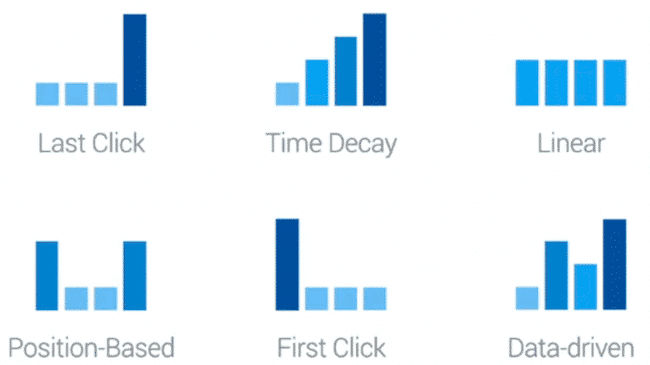
What does shifting to data-driven attribution mean for my business?
Partial conversions
Moving to a DDA model will create conversions for keywords that are <1.
For example, if two keywords are involved in conversion the DDA model may allocate the credit for that conversion as .25 and .75 or .5 and .5. as opposed to giving full credit to the client keyword as a whole number.
Google only
Many advertisers’ digital marketing efforts go beyond just Google ad buying platforms. However, DDA within Google Ads only considers Google properties in attribution modeling.
Let’s say a customer clicks an email, then searches for your brand, then watches a YouTube video before clicking through on Facebook to your website to buy.
In this scenario, Google will only allocate credit to Google proprieties. This could potentially give more credit to a conversion or result in double-counting across analytics platforms or conversion tags you might be using.
What does the data show?
I pulled data across a vast majority of our accounts and looked at the differences between the various models.
I noticed slight differences when indexed against the total number of conversions. So slight that I had to alter the chart’s y-axis to the thousandth place.
The most significant difference was between last click and first click attribution (which makes sense since it’s the biggest difference in strategic approach).
The second closest was last click to data-driven attribution. Even so, the swings were less than 0.3%.
Now, these swings may be larger for advertisers with bigger non-search spend amounts or heavy users of Performance Max campaigns.
However, even the accounts with these features didn’t see that big of a difference to change how we managed them materially.
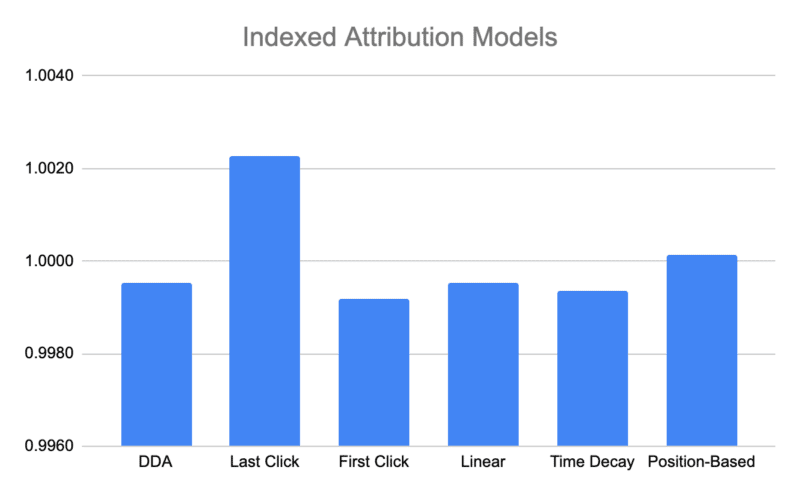
What action should be taken?
This is a very personal choice for the brand. We have seen most of our customers move to DDA, given the smaller change each model has on the total number of prior reported conversions.
Also, the total number of conversions reported out of Google Ads before any shift does not change. Thus, it is just within your account that conversions change. Comparing another tactic like Facebook pre/post won’t be impacted.
Ultimately, the amount of data that Google has on various conversion paths goes beyond any individual advertiser. It also can help provide insights into where cookies or other data is opaque for advertisers (see modeled conversions).
Also, to inform this decision, Google has created the ability to compare various model types. Go to Google Ads and navigate to Tools and Settings > Attribution > Model Comparison.
This tool will allow advertisers to see the variances between the models. Using these comparisons, you can help communicate and educate your internal team about the potential impact.

Overall, data-driven attribution, while not a silver bullet solution completely, provides better insight into various ad types and keywords and how they impact the customer journey.
This will allow your brand to allocate budget and resources better – ultimately optimizing your business to maximize results.
The post Data-driven attribution: How to think about Google’s default attribution model appeared first on Search Engine Land.
from Search Engine Land https://ift.tt/6Xkh7xC
via https://ift.tt/GIxKaBd https://ift.tt/6Xkh7xC
Keyword rank tracking software – 6 tools compared
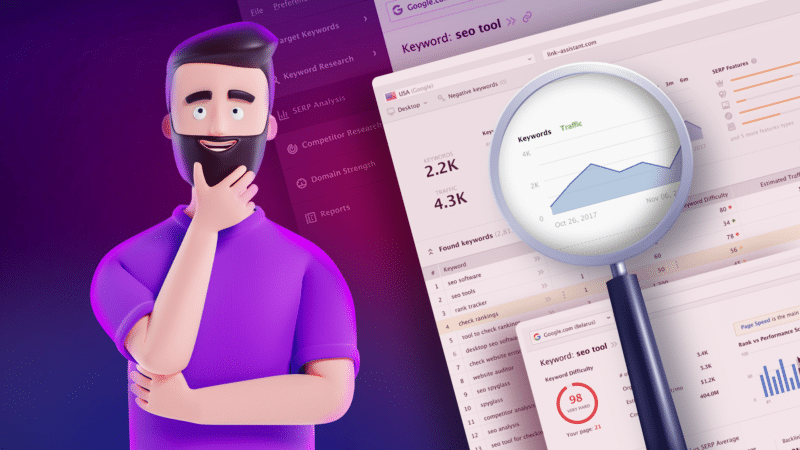
Reliable rank tracker software is crucial to developing a successful SEO strategy. Aside from tracking keyword rankings, SEO tools provide you with keyword research features and useful SEO metrics, which lets you pick the most effective keywords for your website.
With so many rank tracking tools in the market, how do you know which one is the best fit for you? This list includes some popular rank tracking tools, showing what scope of tasks they offer based on different pricing models.
1. Rank Tracker by SEO PowerSuite
Rank Tracker from SEO PowerSuite enables you to track keyword positions, analyze SERPs, research keywords, explore competitors, and make estimates for SEO and PPC campaigns.
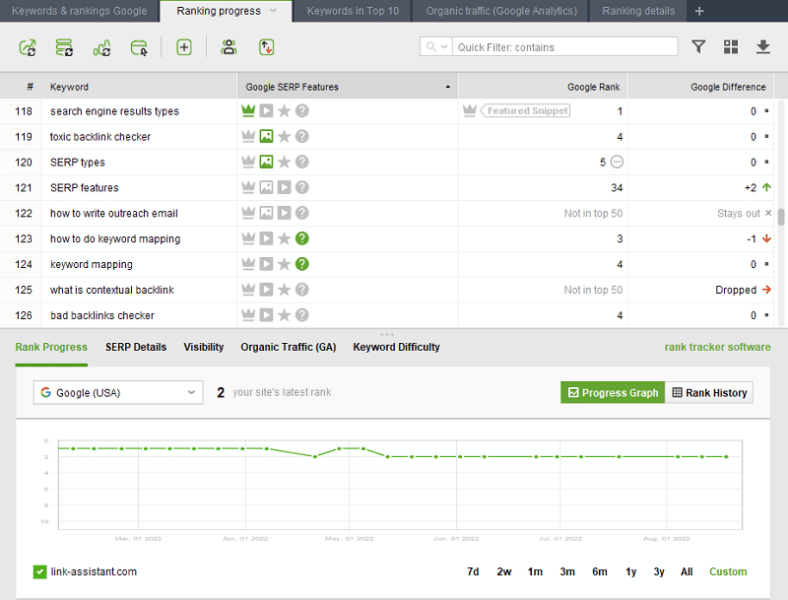
The accuracy and volume of keyword data make it a decent competitor of industry-leading rank-checking tools, such as Semrush or Ahrefs. Meanwhile, Rank Tracker is affordable for small businesses. It is also cost-efficient when it comes to large SEO agencies.
Main features:
- An unlimited number of keywords and projects.
- Local rank tracking: the software supports over 500 search engines in all possible locations, including Yahoo, Bing, Baidu, Naver and others.
- Separate mobile rank tracking.
- Automated ranking checks for regular monitoring of your keyword positions.
- Custom alerts and keyword position reports straight to your or your clients’ email boxes.
- SERP feature analysis: the tool tracks if any of your pages are represented in featured snippets, FAQs, People Also Ask, featured images and videos, etc.
- 24 keyword research techniques: in addition to its own keyword database, Rank Tracker includes Google and YouTube suggestions, related searches, Amazon autocomplete tool, keyword gap, TF-IDF analysis, etc.
- Integration with Google Analytics, Google Search Console and Keyword Planner.
Pricing plans: Free version or Professional $149/year, Enterprise $349/year, billed annually.
Rank Tracker’s free version is pretty generous. It allows checking an unlimited number of keywords and websites. You can compare your rankings with one competitor. Besides, you can research as many keywords as you want.
With the Professional edition, Rank Tracker allows you to record the SERP history and track rankings for up to five competitors. Besides, it allows scheduling keyword position checks.
The Enterprise version of Rank Tracker is great for reporting to SEO clients as it comes with the white-label feature to add your company name and logo to your reports.
2. Mangools
Mangools is web-based software providing various tools for tracking search results. With this tool, you can quickly monitor top gainers and losers in SERPs.
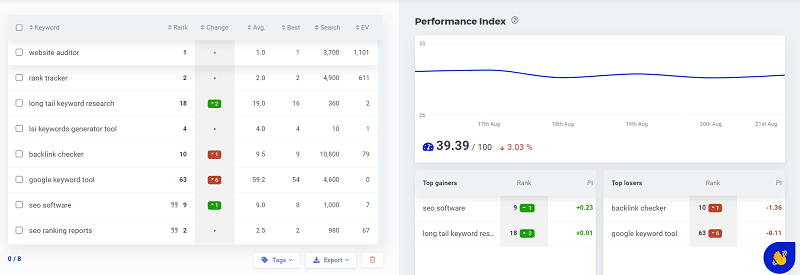
Main features:
- Mangools software calculates the proprietary Performance Index score to show your ranking success.
- The Keyword Position Flow board shows the number of keywords that moved up or down across the SERP. There is a compact dashboard of distribution for your Keyword Positions.
- SERPWatcher shows your keywords’ ranking performance, defined by the target country and user device type.
- SERPСhecker checks rankings on the search results page and their quality (page authority and backlinks). The rank checker also provides a snapshot of the SERP.
- Keyword research tools in Mangools include Related queries, Autocomplete, and Related questions.
- Easy sharing of SEO reports on your search engine rankings.
Pricing plans: Basic $358.80, Premium $478.80, Agency $958.80 if billed annually, monthly billing is available.
Mangool’s pricing plans differ by the limits on the number of keyword lookups per 24 hours. The Basic plan allows up to 100 lookups, 500 lookups are allowed in the Premium plan, and 1,200 lookups in the Agency plan. The number of tracked keywords also ranges from 200 to 700 and 1500 respectively.
This SEO tool offers a fairly limited free trial.
3. SE Ranking
SE Ranking is a cloud-based platform for SEO and online marketing professionals.
Its rank checker has neat keyword dashboards to help you easily understand what’s going on in search results.
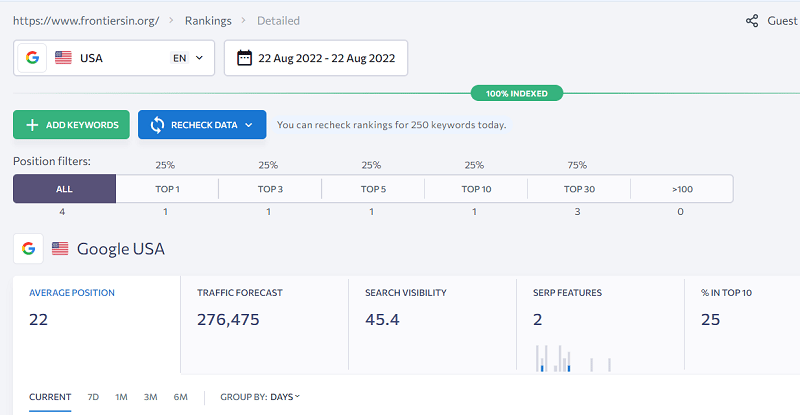
Main features:
- Web-based keyword tracking and site audit platform.
- Allows tracking your site’s ranking positions on Google, Bing, Yahoo, Yandex and YouTube.
- The tool also lets you track local and mobile keyword rankings.
- This rank monitoring tool offers 14 days free trial.
Pricing plans: Essential, Business, and Pro, monthly and yearly billing available.
The pricing plan of the SE Ranking online rank tracker is based on the frequency of your ranking checks: depending on whether you run the checks daily, every three days, or weekly. Besides, there is a limit of 5 search engines or locations per keyword.
The cheapest is the Essential edition, with weekly checks of 250 tracked keywords. It will cost $225 if billed annually. The most advanced Business plan with daily checks for at least 2500 keywords will cost around $1800 if billed yearly.
4. Ahrefs
Ahrefs is a popular SEO and marketing platform that lets you audit websites, research keywords, analyze backlinks, etc. The rank tracker tool in Ahrefs provides a pretty compact dashboard where you can grasp all your trends in keyword rankings at a glance.
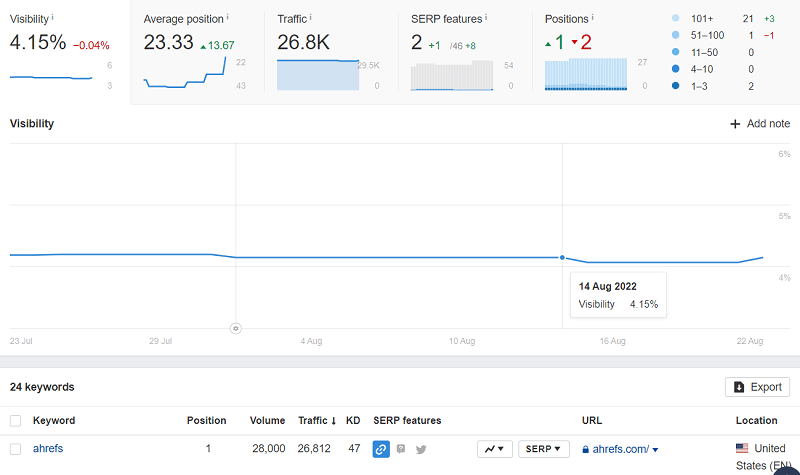
Main features:
- All-in-one web-based SEO software.
- Ahrefs’ Rank Tracker lets you overview top traffic keywords and the SERP in detail, with each result accompanied by important metrics.
- SERP features appear next to each result, and you can unwrap and see all three ranking results in the local pack.
- The filtering tags let you quickly filter the data you need.
- The widely-known metric of Ahrefs is Domain Rating (DR), the score showing the authority of a domain based on its backlink profile.
- In every plan, you will get weekly updates on your ranking progress.
Pricing plans: Lite $990/year, Standard $1,990/year, Advanced $3,990/year, Enterprise $9,990/year if billed annually; monthly billing is available.
Rank tracking history is available in all plans but Lite. Like most cloud-based rank tracking software tools, Ahrefs charges per keyword in the project. The Lite plan allows tracking up to 750 keywords per project; Standard — 2,000 keywords, Advanced — 5,000; and 10,000 keyword checks are available in Enterprise.
There is also a pay-as-you-go option to get additional keyword entries at $50 per 500 keywords. For additional costs, you can get daily checks of your keyword positions.
Ahrefs’ Rank Tracker tool allows an unlimited number of verified projects. But there are limits on tracking the unverified domains, starting with five in the cheapest plan.
5. Semrush
Semrush is an all-in-one web-based solution for a complete SEO and marketing workflow. Due to its costly pricing, it is more suitable for large SEO agencies.
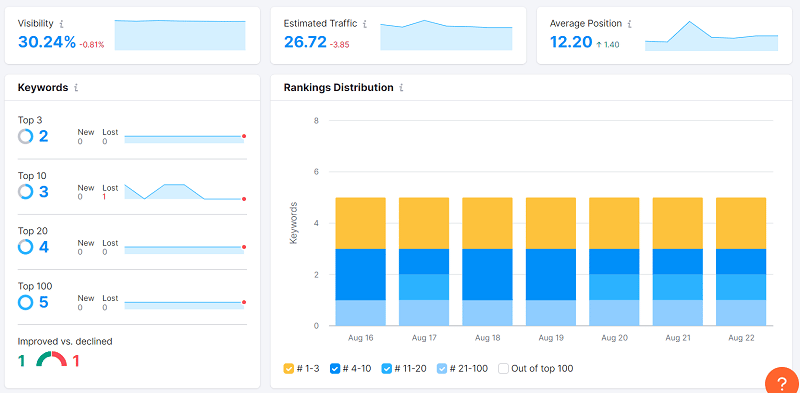
Main features:
- Organic Traffic Insights with all sorts of data: the number of ranking keywords, traffic fluctuation over the last 12 months, and traffic cost.
- Branded vs. non-branded traffic trends, top organic keywords.
- The graph of organic keywords trends shows how many keywords entered the top 3-10 and up to 100 historically.
- The free plan is available with a limit of 10 requests per day.
- 7-day free trial.
Pricing plans: Pro $1,199/year, Guru $ 2,299/year, Business $4,499/year, if billed annually.
Similar to other powerful rank tracking tools, Semrush tracks search engine rankings in multiple countries and languages. However, these features, as well as keeping historical data, are available only with Guru and Business plans.
The Pro plan limit is 500 keywords to track simultaneously per all projects, 1500 for Guru, and 5000 for Business (with the keyword ranking progress updated daily). The number of projects is 5, 15 and 40 respectively. There are also some limits on the number of keyword metrics’ updates per month.
6. Wincher plugin
WordPress enthusiasts know the power of the Yoast SEO plugin. Now they can have even more with the Wincher integration for tracking keyword rankings.

Main features:
- The plugin is used in combination with Yoast SEO.
- Up to 5 key phrases tracking per post.
- The trend of keyword ranking position over time.
Pricing plans: Starter $288/year, Business $588/year, Enterprise $2388/year, if billed annually; monthly billing is also available (the price in U.S. dollars is approximate since the payment is made in euros).
The free version of the Wincher rank tracking plugin is limited to one keyword per five posts, just to give you a slight taste of rank checking. The paid version allows reviewing organic ranking positions of up to 10,000 keywords, with five keyword phrases per post if used in combination with the paid Yoast SEO.
Rank checking in a meaningful way
Hopefully, this comparison list of rank tracking tools will help you figure out what software you need for your tasks. If you are new to rank tracking, read our detailed guide on how to track SEO results and what important metrics to consider.
The post Keyword rank tracking software – 6 tools compared appeared first on Search Engine Land.
from Search Engine Land https://ift.tt/rkNDlIG
via https://ift.tt/GIxKaBd https://ift.tt/rkNDlIG
10 tips to help you become an in-house SEO
Looking to land a new SEO role to grow your career? You may want to consider becoming an in-house SEO specialist.
Thanks to the Great Resignation, more jobs are available and plenty of companies are currently open to remote work gigs. There’s a significant demand for in-house SEO roles, with hundreds of openings advertised around the U.S. alone.
Now’s the ideal time to give it a shot as the demand is high, yet the bar is not too steep. You have the opportunity to improve your own “hireability,” and as a former long-term in-house SEO strategist, I have tips for you.
But first, why look in-house?
Why should you consider an in-house SEO role?
In-house SEO can be advantageous compared to working for small SEO agencies or as an independent consultant. Benefits include things like:
- Great pay (if you do in-house for larger companies or companies in lucrative verticals).
- A more regular work schedule.
- More robust group benefits such as insurance, sick leave, and 401K.
- Stability.
- Supportive teammates and infrastructure.
For instance, a larger company can call an IT person to fix your computer or internet access. In contrast, if you are independent, you may be doing everything ranging from accounting, IT, sales, and advertising to performing your HR functions, hardware upgrades, system admin work, and more.
My experience at doing SEO in-house for one of the world’s largest corporations and subsequently providing strategic guidance for other in-house teams has given me insights into how people may position themselves best for obtaining in-house SEO roles.
Below are 10 tips you can use to land that ideal position.
1. Determine your specialization
There are many aspects to SEO, and it can take considerable time to become a jack-of-all-trades in this arena. You should first look to leverage your existing skills and background.
If you come from computer science and programming, focus on learning:
- In-depth details about HTML code elements related to optimization.
- How structured data is designed within HTML.
- How content management system (CMS) templates may be optimized.
- How programmatic SEO is conducted.
You might also learn how to configure spidering software to perform audits on a website and how this can help review SEO elements across many of a website’s pages.
If your background is in writing, read up on:
- How to perform keyword research.
- How to find sources showing comparative data on keywords and phrase choices for particular topics.
- How content marketing can help attract more links and visitors and improve a website’s performance in search.
- If your background is in graphic design, learn how even attractively designed webpages may have code designed to be optimal without harming the graphic layout and styling of the site.
Those with a business analytics background should learn:
- How to use web analytics packages to assess websites’ performance in search results.
- How this performance data can indicate areas for potential improvement or reveal a site’s top-performing content.
You will use your specialization as a starting point and then work to expand your knowledge and skills to be more of a generalist in SEO later.
A specialization frequently helps you get your foot in the door with a company since those skills may match up with more available positions, albeit there have been increasing roles available as SEO specialists.
2. Learn the basics
This advice likely goes without saying, but all those interested in working in SEO should read up on the most influential and simplest ranking factors, and how to assess whether a website has them established.
Before writing this piece, I posted a poll on Twitter asking what one thing someone should do to prep to become an in-house SEO. The number one item that voted for was “Read Google’s Webmaster Guidelines and SEO Documentation.”
Google’s Webmaster Guidelines are general advice on what Google likes and dislikes. There’s also SEO documentation, including an SEO Starter Guide, that provides dependable, authoritative introductory instruction on SEO.
While it is easy to hyper-focus on the industry juggernaut, there’s value in reading Bing’s Webmaster Guidelines. Many SEO elements are parallel in Microsoft Bing, but there are differences.
According to my informal Twitter poll, SEO books were not a popular suggestion for learning the craft, but there are good ones out there that can help you learn SEO very well. Some of these SEO books can also be very helpful when researching issues that may come up outside the basics.
If you are a beginner, read a beginner’s guide – just not one marketed to “dummies” because you are not a dummy! Also, The Art of SEO is a great reference book, although I would not recommend it as a guide for beginning to learn the craft. The great thing about having books on your desk for reference can be a great resource to point to when someone does not believe you, and you need an authority to point to.
3. Learn HTML
Hypertext Markup Language, or HTML, is the formatting instruction protocol that tells browsers how to display webpage content.
A page’s HTML can be very complex and resembles programming code, so this may seem daunting. However, it is pretty easy.
You can view any webpages’ HTML code – often by right-clicking on the page in your browser window and selecting “View page source.” You can also view the code that composes the page by adding “View-source:” in front of the page’s URL in the browser address bar and clicking “Return” to view it.
You can learn HTML just by viewing code this way, but many webpages are so complex that this will prove frustrating.
You can also refer to online video tutorials on how to write HTML and guides and articles for learning the language.
Some of the best tutorials provide a “sandbox” area on the webpage for one to write HTML directly, which will immediately display the result. For instance, the Learn-HTML.org website provides instructions and sandbox areas to try out the code.
Once you have learned HTML, you might also learn further about CSS and JavaScript basics as they are closely intertwined in contemporary websites.
4. Create your own website and optimize it
Nothing beats hands-on experience, and this is ideal for learning both HTML and SEO. No matter your skill level, this should be an option open for you.
Make a website around your personal interest because it should be a topic that will inspire you to work on the site.
A personal website can also provide you with a safe space to experiment with different aspects of SEO, such as structured data, redirects, and image SEO.
When I hired code developers at Verizon, it was sometimes difficult to select between many qualified candidates.
But I found that those who had developed their own websites were typically an order of magnitude better for SEO and brought more real-world experience and skills to the table.
You do not have to hand-code HTML and CMS to launch your own website.
If you’re not as familiar with web coding, you could choose to go with a web host company that provides turnkey WordPress installations. You could also try Wix or other CMS.
If you have time and inclination, it is great to set up a few websites on a few different CMS platforms to gain skills and advanced understanding.
When you achieve rankings for key terms related to your topic, you could use your website as an example of your work.
5. Intern
Many agencies and top consultants may accept interns or apprentices in return for work. Take on such a gig to gain further experience and enhance your resume for landing a desired in-house SEO position.
Beware, however. There is a difference between cold-calling people or agencies you admire and applying for listed intern positions. Those of us operating agencies receive many cold-call offers from off-shore developers, lead-gen partners, and people offering to do work for us.
So, you will have to either focus only on applying for posted internship positions or go to extra effort to court an agency or independent consultant compellingly enough to break through all the noise.
Once you have an intern position, you may use it to step up into another role that helps build your job history into your dream in-house SEO role.
6. Campaign for a lateral move within an organization
It may be easier to initially get a position within a company for a non-SEO role, but you can then work to transition yourself into providing SEO analysis, guidance or development.
Discover who within the company are the decision makers who can approve SEO efforts or who may already be providing SEO guidance to an extent.
If there is already a primary in-house SEO person, you may be able to campaign to work with them as a team member, or you may be able to assist them from your existing position.
Often, the SEO role is shared in some way between the Marketing and IT departments. (In other places, it could even be in the Sales or Business Development departments.)
Individuals who carefully and sensitively position themselves to help facilitate SEO and can communicate its value proposition while exploring ways to make optimizations happen have an edge. They can have a role created specifically
7. Develop your soft skills
This tip likely needs to be my number one recommendation for in-house SEOs!
You would think that SEO cleverness might be the most beneficial skill for these roles – and, I think it should be considered second to soft skills.
But being diplomatic and communicating effectively and professionally will get you further along in your career than nearly anything else.
You may dream of ranting in an offended, dramatic tone when your system admin bans the pesky Googlebot and Bingbot, but you also may need that person to do you a favor later. Thus, embarrassing them in front of leadership will not win you a friend and ally.
As an in-house SEO, you not only need to be able to convey ROI advantages to your leadership, you will need to persuade others to collaborate with you and inspire everyone to work toward increasing qualified referral traffic.
When I was younger in my career, my mentors suggested improving my soft skills – picking up the phone more rather than attempting to direct and persuade through email.
They were right. I have also seen younger SEO professionals hamstring their career growth through too-blunt and unprofessional speech.
Even worse, others have tripped up in dealing with others because they did not understand the value of maintaining culturally sensitive communications in professional settings.
Consider bolstering your ability to do public speaking and writing well.
And, seriously, take sensitivity and diversity training courses online.
8. Stay up to date on SEO developments
One mark of professionals in the SEO industry is that we must all keep up with a rapidly evolving landscape. Read the top news emerging here on Search Engine Land and Search Engine Roundtable, as well as top articles in other publications.
You might also want to read the commentaries about new and emerging things written by top consultants in the industry.
Some articles posted on the major SEO tools’ websites are also very good quality – particularly the research studies that they conduct from time to time.
Search engines publish thousands of changes per year, so reading the articles posted each week on major websites can distill down the information to the most important for you to consume.
Make a consistent habit, and you will not fall behind or go stale.
9. Attend an SEO conference, meet-up and/or workshop
There are plenty of conferences, meet-ups, and workshops provided around the world. One upside of the pandemic era is that you can attend many of these from the comfort of your own home.
Frequently, these may be more beneficial to people who are a little more advanced than beginner-level. Regardless, they feature presentations by experienced people from whom you may learn a lot.
According to my informal poll, this was not one of the popular options for preparing for in-house roles, but that could be because conferences can be pricey.
If you have the budget to invest, do this for the sake of professional development. If you do not, look for free opportunities. Also, consider lower-cost options, such as attending regional search marketing association meetings.
Other in-person conferences may also allow you to attend sessions in return for working at the conference.
Larger conferences are often attended by many in-house SEOs looking to expand their knowledge. As such, those already working for a large company should campaign to get the company to pay their way to one or two conferences per year.
Having the company’s in-house SEO staff become more educated on the intricacies of optimization can pay off in dividends as the company’s website may rank higher and gain more qualified visitors.
10. Become Google Analytics certified
Understanding web analytics is a crucial skill for people in SEO.
Going through Google Analytics’s training program formalizes that understanding. It can help you evaluate your optimization work’s effectiveness and research what is bringing people to your site.
You should also become fully familiar with Google Search Console to see critical analytic information related to your organic search presence.
Certification also helps you appear serious as a professional in SEO, which is unquestionably beneficial for an in-house career.
Web analytics are undergoing a serious sea-change at the moment, unfortunately, with the transition from the traditional GA Universal Analytics to GA4. Some of the analytics may become a little dumbed-down from what it has been in the past. Consider familiarizing yourself with alternative analytics services out there.
One final, bonus tip
Do not let “imposter syndrome” hold you back, make you feel insecure about applying for SEO positions or make you too hesitant to campaign to attain the SEO role you desire.
While SEO has evolved over the past 20 years, it is also completely approachable, regardless of your degree of technical knowledge.
It is still the case that a simple webpage with a beautifully written article may outperform another webpage on the same topic that is technically optimized to the Nth degree.
You absolutely should endeavor to expand your own knowledge and skills, but you can do this without feeling reticent to assert yourself as a professional in the field.
There are short-sighted gatekeepers in SEO because it is a field that can attract people who want to create a territory for themselves without having to jump through a lot of formal hoops to do so.
That said, there is a lot of room for new participants to join in, and people don’t have to try to make it seem harder than necessary.
You do not have to be a hardcore programmer or have umpteen advanced degrees to do SEO.
You just need a desire to push for quality, informed by understanding what works well with the search engines.
The post 10 tips to help you become an in-house SEO appeared first on Search Engine Land.
from Search Engine Land https://ift.tt/CFXPW6f
via https://ift.tt/GIxKaBd https://ift.tt/CFXPW6f
On Camera, Truck Runs Over Man As His Bike Loses Balance Due To Pothole
Sunday, August 28, 2022
Jharkhand Schoolgirl Dies After Stalker Set Her On Fire: Police
Girl, 2, Dies In Gas Cylinder Blast While Inflating Balloon In Maharashtra
Mumbai's Iconic Double-Decker Busses Now In Electric Avatar
Saturday, August 27, 2022
Ahead Of Big Noida Demolition, Street Dogs Taken To Safety
Noida Twin Towers Demolition: How Police Have Prepped For Blast
Noida Twin Towers To Go Down Today: 10 Numbers That Sum Up Demolition Plan
Friday, August 26, 2022
Woman Delhi Constable Allegedly Dies By Suicide: Police
Man's Decomposing Body Found In Gurgaon Hostel, Missing Roommate Charged
The latest jobs in search marketing
Every week, we feature fresh job listings for search marketers. Make sure to bookmark this page and check back every Friday.
Are you looking to hire? You can submit your listing here for free. Please note that we do not include listings without a salary range.
Newest jobs in SEO, PPC and marketing
Manager, Google Ads, Lionhurst (Remote)
- Salary: $65,000 – $70,000 (annual)
- Build, manage and optimize campaigns on Google Ads and Microsoft Ads for B2B SaaS companies.
- Assist with client communication and project management
Director of SEO, Workshop Digital (Remote, U.S.)
- Salary: $120,000+ (annual)
- Develop and implement a strategic vision for the SEO team
- Maintain standards of performance and ensure successful SOW execution across an evolving and expanding set of SEO services
Paid Search Senior Strategist, Socium Media (Remote, U.S.)
- Salary: $70,000 – $85,000
- Run day-to-day paid search operations for clients that could span across multiple verticals
- Will likely be fully managing and be the sole “owner” of at least one client within the first two months, depending on business needs
Open jobs in SEO, PPC and marketing
Senior Program Manager, SEO, Amazon Web Services (AWS) (Seattle)
- Salary: $71,000 to $131,000 (annual)
- Developing processes and mechanisms for efficiency and improved communication and collaboration within the team as well as with partnering teams and stakeholders.
- Collaborate on highly visible cross-functional SEO initiatives throughout the project lifecycle, from gathering requirements, design and development, to testing, launch, and support.
Global Head of SEO, Glassdoor (Remote or San Francisco, Cleveland, Chicago, London, Dublin)
- Salary: $127,000 to $190,000 (annual)
- Lead all aspects of globally-distributed, experienced, in-house SEO team, including three direct reports. This is a player-coach role, and as the team lead you will have individual responsibility for the most strategically important SEO projects.
- Partner with a product/engineering team that is specifically dedicated to SEO infrastructure and enablement.
Product Manager, SEO, REI (Remote)
- Salary: $75,000 to $147,500 (annual)
- Articulates the product vision and clearly translates the vision into clear requirements for the roadmap.
- Responsible for a component or set of components within the platform with a well-understood customer base. Expected to deliver impactful data and services.
PPC Director, Upgrow (Remote, U.S. hours)
- Salary: Starting at $110,000 (annual)
- Establish how Upgrow delivers PPC, create playbooks and process documentation, determine the tools and roles we require, and essentially own all things PPC.
- Work with your team to create an effective PPC strategy for each client and offer client support when needed.
Paid Acquisition Account Manager, Jordan Digital Marketing (Remote)
- Salary: $75,000 to $95,000 (annual)
- Executing paid search and paid social strategy for clients
- Conducting strategic planning and optimization efforts
Sr SEO Manager, deeproots partners (Remote, U.S. hours)
- Salary: $75,000 to $96,000 (annual)
- Staying constantly up-to-date on new onsite strategies for local SEO (with an emphasis on Google My Business) and national campaigns and working with the COO to create SOPs to implement within the agency.
- Ensuring that we reach our partners’ KPIs in the desired timeline by managing existing and new strategies with the SEO team (Chief SEO Strategist and SEO Analyst).
Digital Marketing Paid Internship (PPC and SEO), Cardinal Digital Marketing (Atlanta / Hybrid)
- Salary: $15 (hourly), 35 hours per week
- Must be local to Atlanta and a senior graduating by December 2022
- Learn from either the Paid Search or SEO team
Digital Marketing Platform Manager, Harvard Business School (Boston / Hybrid)
- Salary: $70,000 to $75,000 (annual)
- Act as project manager for SEO and related website updates.
- Create new websites and pages using CMS templates and modules.
PPC Specialist, Vital Design (Portsmouth, N.H. / Hybrid)
- Salary: $50,000 to $95,000 (annual)
- Build highly targeted PPC campaigns (from scratch) across multiple channels.
- Manage multiple clients’ expectations, strategies, budgets, and conversions.
Digital Marketing Specialist (PPC & SEO), Adena Health System (Chillicothe, Ohio / Hybrid)
- Salary: $44,137 to $73,569 (annual)
- Under the director of the Director, takes leadership and accountability of SEO strategy and execution that may include audits, social integration, linking programs, content development, profile management, conversion optimization, analytics and report generations
- Manages the PPC strategy and execution throughout all phases including development, design, launch, evaluation, and reporting to meet business objectives
PPC Specialist, Saltwater (Remote)
- Salary: $65,000 to $75,000 (annual)
- Ongoing management of paid search and paid social campaigns across paid media clients.
- Work with the Director of Paid Media to identify appropriate goals, KPIs, target segments, and creative requirements for successful PPC campaigns.
Channel Strategist SEO/SEM Manager, Green Dot Agency (Remote / multiple locations)
- Salary: $86,000 to $159,000 (Remote or Multiple Locations)
- Lead programs and projects designed to maintain and evolve SEO and content strategy program including, but not limited to, channel strategy, implementation of new channels or new tactics, development of roadmaps, and channel governance.
- Collaborate cross-functionally with strategic marketers, strategists, data storytellers, and creative colleagues to drive data-driven channel strategies that align with stakeholder goals and drive business impact.
SEO Specialist, Blennd (Denver, Colo., Hybrid / Remote)
- Salary: $55,000 to $65,000 (annual)
- Develop a strong understanding of branding requirements for clients as it relates to SEO initiatives.
- Perform technical site health audits to provide insights, itemize issues, and implement fixes.
SEO Marketer, Anglepoint (U.S. / remote)
- Salary: $60,000 to $80,000
- Develop optimization strategies that increase the company’s search engine results rankings
- Research SEO keywords to use throughout the company’s website and marketing materials
Sr. Paid Search Strategist, Inflow (Remote, U.S. only)
- Salary: $74,000–$97,000
- Manage and serve as the primary point of contact for 5–10 paid advertising clients. Be responsible for the strategy, prioritization, planning, and execution for client PPC strategies in Google Ads, Microsoft Ads, and other relevant platforms.
- Build highly effective Shopping, Search, Display, and Remarketing campaigns for eCommerce clients.
Paid Ads Team Manager, Inflow (Remote, U.S. only)
- Salary: $80,000 to $118,000
- Lead strategic planning sessions and team meetings
- Review deliverables and provide feedback to other team members
SEO Analyst, UnitedHealth Group (Eden Prairie, MN, Remote considered)
- Salary: $66,000 to $118,300 (annual)
- Leverage tools like Semrush and Google Search Console to compile organic search performance data to inform content recommendations
- Partner with segment stakeholders to fully understand their products, services, customers, and unique business objectives
SEO Strategist, Inflow (Remote)
- Salary: $67,000 to $86,000
- Serve a small set of accounts as the lead SEO Strategist/Client Advocate
- Collaborate with Sr. SEO Strategists to assist with execution of SEO deliverables
Search Engine Optimization (SEO) Analyst (Senior and Expert), Bruce Clay (Remote)
- Salary: $5,000 to $10,000 (monthly)
- Technical deep-dive deliverables with extraordinary mentoring and client communication skills required.
- Increase keyword rankings and search engine traffic and ultimately conversions for client websites within exceptionally competitive search engine results pages.
SEO Manager, CharterUP (Remote/Atlanta)
- Salary: $70,000 to $90,000 (annual)
- Collaborate on outreach strategies and link building
- Analyze existing sites for content and on-page optimization opportunities
Sr Analyst, SEO, Home Depot (Remote)
- Salary: $65,000 to $100,000 (annual)
- Perform continuous site auditing, and recommend scalable on-page optimization based on business objectives for both existing functionality and new opportunities
- Provide SEO best practices in alignment with current technical principles and homedepot.com systems
Senior SEO + Digital Strategy Analyst, Momentic (Remote or Milwaukee)
- Salary: $65,000 to $85,000 (annual)
- Developing, executing, and reporting on comprehensive SEO strategies.
- Identifying key SEO opportunities, tracking website traffic and KPIs, and analyzing competitor strategies.
SEO Testing Consultant, Search Pilot (Seattle, hybrid)
- Salary: $65,000 to $90,000
- Managing the customer relationship, including onboarding of new customers and keeping them updated on test planning and results
- Coming up with SEO and CRO test hypotheses and working with customers to prioritize them
Senior SEO Specialist ~ Pure Visibility (Remote or Ann Arbor, Mich.)
- Salary: $58,000 to $65,000 (annual)
- Work with the SEO director to perform in-depth visibility audits for new clients and compile the results along with prioritized recommendations.
- Work with the SEO director to analyze and create action plans around common technical SEO components (canonicalization, sitemaps, crawl budget, schema, hreflang)
Senior Paid Search Manager, Kingpin Communications (U.S. remote)
- Salary: $70,000 to $90,000 (annual)
- Assist the Global Head of Paid Search in the day-to-day management of accounts.
- Manage the day-to-day housekeeping by running, optimizing, and analyzing paid search campaigns across Google and Bing.
Digital Marketing Specialist, New American Funding (U.S. remote)
- Salary: $65,000 to $85,000 (annual)
- Integral role in planning and execution of performance campaigns spanning across digital channels
- Collaborate with design team on writing and implementing advertising copy for display/search ads, landing pages, video and positioning to ensure brand standards and accuracy
Want a chance to include your job listing on Search Engine Land? Submit your details here.
The post The latest jobs in search marketing appeared first on Search Engine Land.
from Search Engine Land https://ift.tt/WoDAuM0
via https://ift.tt/4ugS2Yy https://ift.tt/WoDAuM0
"Couples Not Allowed" Board Outside Pune Garden Sparks Row
"A Dream Come True": Man Who Will Press Button To Demolish Noida Towers
Thursday, August 25, 2022
Webinar: Why digital changes drive SEO growth

Effective digital transformation can accelerate organic marketing growth—and maintain that growth despite future economic or regulatory challenges.
Join search experts from Conductor in an upcoming webinar and learn:
- The crucial role organic and SEO play in enterprise digital transformation.
- The importance of diversifying marketing efforts and what that looks like.
- How to apply data-driven insights to elevate the customer experience.
Register today for “Beyond the Buzzword: Transform Digitally to Drive Organic & SEO Growth,” presented by Conductor.
The post Webinar: Why digital changes drive SEO growth appeared first on Search Engine Land.
from Search Engine Land https://ift.tt/j95EXlT
via https://ift.tt/pz9WQYj https://ift.tt/j95EXlT
Google out-of-home ads available for Display and 360
Google has just announced digital out-of-home ads for Display & 360. The new ad formats help to engage shoppers when they’re “out in the real world” in front of screens in public places such as stadiums, airports, bus stops, shopping centers, elevators, taxis, and more.
How they work. With digital out-of-home ads in Display and 360, brands can harness the same power of traditional advertising with placements on public screens, all in one dashboard where they can control strategy, reporting, and optimization.
Digital out-of-home ads also allow brands to run multiple versions of their message and can be based on location and time of day.
Google’s programmatic partners. “Display & Video 360 already partners with exchanges Hivestack, Magnite, PlaceExchange, Ströer SSP, VIOOH and Vistar Media. These exchanges give access to large media owners around the world like ClearChannel, Intersection, JCDecaux, Lamar and Ströer. All of this inventory can be secured via programmatic deals.”
Limited targeting and personalization. Google says that digital out-of-home ads are not personalized and no unique identifiers are used, as well as no user location data. However, advertisers are able to reach people based solely on contextual information such as the screen location.
For example, Google says a fast food business can quickly advertise on a billboard in a busy spot during lunch hour. Later that day the same billboard can promote a concert or event.
Early testing. Retailer ASOS used digital billboards in heavy footfall areas to generate awareness for their brand and drive passersby to visit their online store. Their marketing team arranged Programmatic Guaranteed deals with leading publishers like Intersection in the U.S. and JCDecaux in the U.K. and booked hundreds of digital billboards, generating 22 million viewed impressions across the two countries.

Learn more about digital out-of-home ads. You can read Google’s announcement here. If you’re interested in purchasing out-of-home inventory you can visit the Display & 360 help documentation.
Why we care. Digital out-of-home-ads are similar to traditional billboards, but instead of paying to have your ad shown in one location, all the time, you can elect to have your ad shown at certain times, in multiple locations.
These new ad types may work well for national or global brands like ASOS, Nike, Mcdonald’s, or Facebook, but small and local businesses may have a tougher time justifying their use. If you can’t specify the audience you’re targeting, and can only adjust their location or screen type, it’s likely not a solution for brands hyper-targeting a certain demographic or audience. But if you have the budget, it may be worth it to test a few cities where you operate.
The post Google out-of-home ads available for Display and 360 appeared first on Search Engine Land.
from Search Engine Land https://ift.tt/RC23uh8
via https://ift.tt/pz9WQYj https://ift.tt/RC23uh8
Techie Creates Fake Twitter Account Of President's Daughter, Arrested
Boy On Bike Shoots 16-Year-Old Girl In South Delhi: Police
"Please No Media Trials": Mamata Banerjee Amid Cases Against Party Leaders
5 ecommerce SEO trends to know for the 2022 holidays
The all-important Q4 holiday shopping season is nearly here. SEO will once again be a critical channel for brands to increase their visibility and sales.
Ahead of the 2022 holidays, enterprise SEO platform BrightEdge has shared its latest research with Search Engine Land on what retailers, brands and publishers should know.
The insights are based on tracking 6,000 ecommerce keywords in 10 categories, which the company has been doing for the past three years.
Here’s what to know:
1. Brands and publishers are big competition for retailers. Retailers are no longer just competing for visibility with other retailers. Now they’re competing with brands that have adopted direct-to-consumer models. Plus, publishers that provide reviews and product overviews have made significant gains in Google’s search results.
For top ecommerce keywords:
- Retailers own 57%, down from 70% in 2020.
- Brands occupy 23%, up from 18% in 2020.
- Publishers have 11%, up from 4% in 2020.
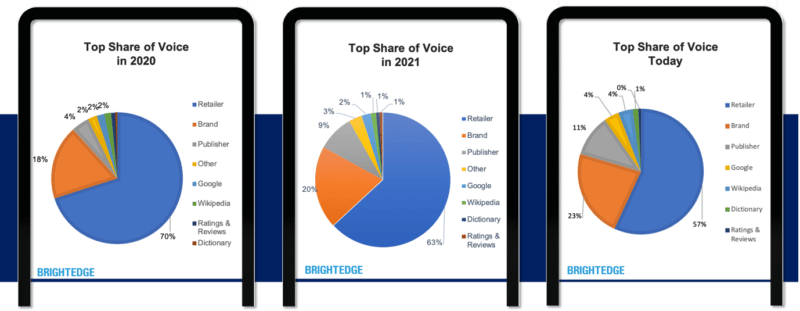
2. Content-driven ecommerce. While it remains to be seen how impactful Google’s helpful content update will be, one thing is clear, according to BrightEdge: the time is now for retailers to differentiate their content so it will rank in search results. In other words, offer more than a product description.
Retailers that ultimately will win are those that will provide better content experiences. How? By:
- Focusing on content and context about the product.
- Organizing categories in ways that make it easy for the user to shop across multiple related products.
3. Blue links matter. There’s been a lot of discussion in the past decade or so about how Google is much more than 10 blue links. For key ecommerce terms, however, 70% of all clicks are going to those classic blue links, according to BrightEdge’s data.
It’s still common to find the local three-pack for ecommerce search terms on Google. However, the prominence of local packs has declined from 25% to 19% in the past two years. Also in decline: videos and image carousels. Meanwhile, People Also Ask has grown slightly.
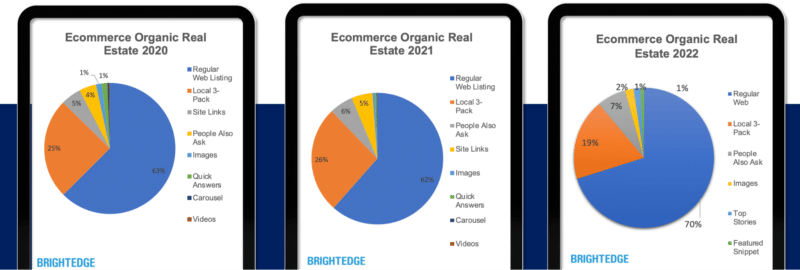
4. Schema usage is growing. Schema is more aligned with shopping than ever this year. Brands, retailers and publishers are increasingly adopting various schema types to markup their content around shopping experiences, such as.
- Product
- ImageObject
- ItemList
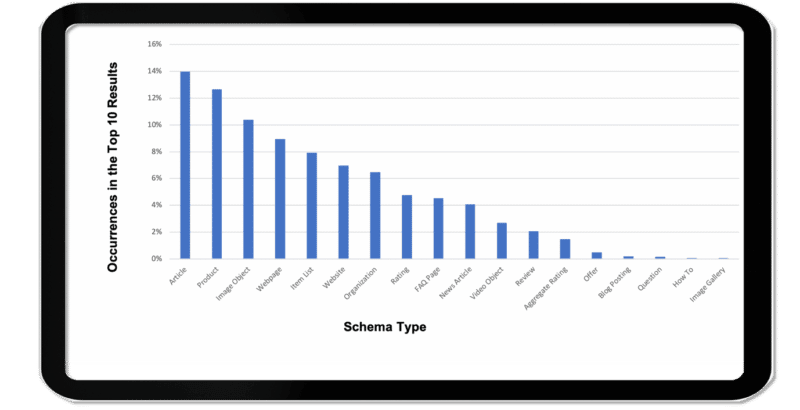
5. Article and category pages dominate ecommerce. Category pages have the highest click-through rate 70% of the time. Also of note: articles about products have higher click-through rates than product pages themselves, according to BrightEdge.
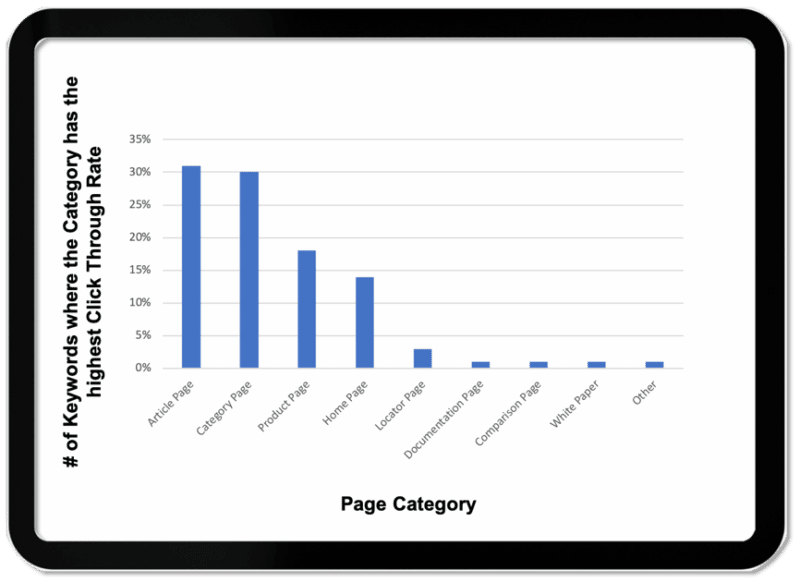
Why we care. Google search – and the way people search – are always evolving. In ecommerce SEO, it’s critical to monitor what’s happening and understand what you can influence now for the upcoming holiday season, while always evolving your SEO strategy to provide the types of content and user experiences Google is likely to reward in the future.
The post 5 ecommerce SEO trends to know for the 2022 holidays appeared first on Search Engine Land.
from Search Engine Land https://ift.tt/z2Mr4av
via https://ift.tt/pz9WQYj https://ift.tt/z2Mr4av